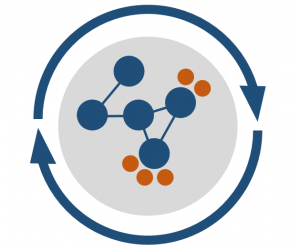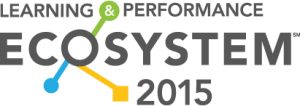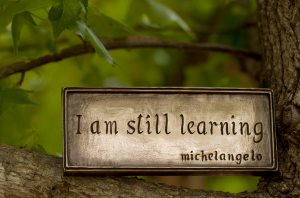Learning has Evolved: Has Your Strategy Kept Pace?
There’s a lot of talk about learning in our industry. We talk about how important learning is to individuals and organizations. We talk about how learning supports an organization’s ability to innovate, and an individual’s ability to grow and move forward personally and professionally. And we talk about building a organizational strategy that helps foster learning.
Too often though, our talk about a “learning strategy” is just that – talk. Not many organizations truly have a learning strategy. What they have is a training strategy, and training is no longer enough on its own to support the changing needs of today’s workforce.
The History of Learning Strategy
If you ask the average worker what their organization does to support learning, it’s likely that the answer will sound a lot like training. You’ll hear about formal education methods like classroom training and elearning. What most organizations provide for learning falls under the heading of instruction. I’ve always believed it has a lot to do with 12+ years of schooling that has conditioned us into believing “learning” means “being taught”. The baggage of “what learning looks like” is something organizational learning and performance professionals have been carrying for decades.
Another reason training is often at the core of an organizational strategy is that it has been the primary, and often only option on the table to support organizational learning. The technological innovations we see as commonplace today have only been accessible to the average organization for the past 10-15 years. The expectation that “learning = training” within organizations is something that has been baked into organization culture for decades.
It’s part of the reason that much of the technology-based training we provide today looks very much like the classroom-based training we’ve done in the past – old habits die hard.
Learning Has Evolved
At a very basic level, we learn from the interactions we have with the things we are exposed to. We are presented with some sort of information, and we process it in some way.
Think about how we are exposed to information today. Instead of volumes of encyclopedias filled with entries that are extremely dated, we carry the limitless information of the internet in our pockets, available to us on demand, and updated in real-time. Instead of a single teacher as the source of knowledge, we have access to individuals and expertise from virtually anyone on the planet. Rather than content being something only “experts” can provide, we have an environment where anyone can share anything they find of value with the world. Rather than signing up for a course to learn a new skill, we search for a YouTube video someone has recorded showing the skill in practice.
The bottom line is that the environment in which learning takes place is radically different than it was even a decade earlier. Learning naturally adapts to the changes of the world, and through the patterns of changed behavior the expectations for what learning “looks like” evolve accordingly.
Shifting to a Learning and Performance Strategy
 When it comes to strategy, we need to adapt our approaches to the changes going on around us. Technology has changed the expectation for accessing information and interacting with it. We are an increasingly self-service culture that expects to be able to access information to solve problems instantly. The world already operates in a self-service “I want to learn about this now” or “I need help completing this task” environment on a personal level. We need to shift our focus in this direction at an organizational level as well.
When it comes to strategy, we need to adapt our approaches to the changes going on around us. Technology has changed the expectation for accessing information and interacting with it. We are an increasingly self-service culture that expects to be able to access information to solve problems instantly. The world already operates in a self-service “I want to learn about this now” or “I need help completing this task” environment on a personal level. We need to shift our focus in this direction at an organizational level as well.
Training doesn’t move at the speed needed to support this new world. Training has it’s place and it will continue to serve it’s valuable purpose in the future. But it’s place as the default solution to performance problems doesn’t fit in today’s world, let alone in the way the world is evolving. We need to open our eyes to the world around us, and how it is changing. We need to see how people’s learning behaviors are naturally adapting to new technologies, and build support to remove barriers and enhance it.
This is not an easy change. As I mentioned earlier, there’s a lot of legacy and associated baggage attached to “learning = training”. The first step towards building a true learning and performance strategy is to see your organization differently. You need to look at the organization as a system, with the worker in the center. Everything that surrounds that worker – from the technologies, to the systems, to the people, to the processes – combine and interact to create an environment in which learning takes place.
The learning and performance strategies of tomorrow need to focus on this environment. We need to consider all of the factors that affect a workers ability to learn and perform their role within that environment. We need to consider what resources can be introduced to the environment that can be supportive – a list of potential resources that include much more than just training. We also need to consider what barriers are present in the environment and how we might be able to remove them.
This new approach to strategy looks at the environment in which learning and performance takes place as a living ecosystem. It’s only when the ecosystem is nurtured and supported that those living and working in it can thrive.
But it starts by seeing our world in a new way.
Join the Ecosystem Conversation
For many, this viewpoint is new. It may take some time to contextualize what this shift means to you, your organization, and our industry as a whole. I encourage you to join conversations around this topic to help bring clarity to what it means for your work.
Learn More:
 The 2015 Learning and Performance Ecosystem Conference takes place this March. It’s the only event fully dedicated to exploring the shifting face of organizational strategy as it related to learning and performance.
The 2015 Learning and Performance Ecosystem Conference takes place this March. It’s the only event fully dedicated to exploring the shifting face of organizational strategy as it related to learning and performance. - Follow EcoSysCon, the official twitter account for the Learning and Performance Ecosystem Conference. You can also track the hashtag #EcoCon to join in the conversations taking place on Twitter around the topic.
- Read some of the white papers, magazine articles, and blog posts exploring the Learning and Performance Ecosystem.


Leave a Reply to The Most PROVOCATIVE Shout-Outs From Today’s Learning Innovators | Learnnovators Cancel reply